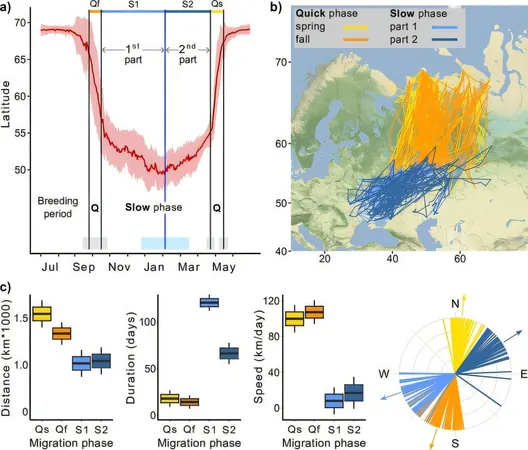
Groundbreaking Research Uncovers Surprising New Migration Patterns in Arctic Raptors!
2024-11-11
Author: Siti
Introduction
In a revelation that could change the way we understand the migration habits of birds, leading scientists from the Max Planck Institute of Animal Behavior have uncovered a significant shift in the winter behavior of raptors, particularly the rough-legged buzzard. Historically, ornithologists believed that migratory birds would travel to their winter habitats, remain there throughout the cold months, and return in the spring. This conventional wisdom has been the cornerstone for determining conservation strategies and delineating their wintering ranges.
Dynamic Winter Range
However, the team’s innovative study challenges this long-held belief, suggesting that the winter range of these magnificent birds is not static, but rather highly dynamic.
The Foxtrot Migration
The rough-legged buzzard, known for nesting in the Arctic and migrating down to mid-latitudes during the winter, exhibits a unique pattern of movement that scientists have dubbed “foxtrot migration.” Unlike a simple straight-line migration, these raptors embark on a rapid journey of about 1,500 kilometers to warmer areas within two weeks. What sets them apart is their continued movement during winter; they inch southwest at a much slower rate, ultimately traveling an additional 1,000 kilometers before gearing up for their swift return to the Arctic by mid-April.
Survey Limitations
The findings were published in the influential journal eLife. They reveal that during the winter, while mid-winter surveys—like North America's Christmas Bird Counts—often classify regions based on dense bird populations, the reality is misleading. The research indicates that these surveys may overlook large parts of the wintering period where the majority of the birds actually reside in the northeastern areas of their range, only temporarily shifting to the southwestern regions during peak winter weeks.
Implications of the Research
Lead author Ivan Pokrovsky raises a pivotal question: “What if birds are moving throughout winter? If we solely rely on mid-winter counts, we risk misinterpreting their population dynamics.” This study highlights the critical need for comprehensive tracking of birds throughout the entire wintering period to create accurate maps of their habitat and inform conservation efforts.
Impact of Climate Variability
Moreover, the findings of this research carry significant implications for our understanding of bird populations facing changes due to climate variability. Changes in snow cover can greatly influence where these raptors thrive over the winter, pushing their range and potentially altering their population distribution. This highlights the potential dangers of incorrectly assessing species populations—if sightings decline in one area, it doesn’t necessarily indicate a population decrease. Instead, it might simply reflect their shift to new winter habitats.
The Importance of Year-Round Tracking
As the climate continues to change and present new challenges for wildlife, the study emphasizes the necessity of advanced tracking technologies to gain insight into animal behaviors. Martin Wikelski, a senior author of the study, asserts, “This research underscores the importance of year-round animal tracking and the invaluable insights it provides. Such data is crucial in helping us navigate the complex landscape of conservation in our rapidly changing environment.”
Conclusion
In summary, as we delve deeper into the lifecycles of migratory birds, such studies not only reshape our understanding of their behaviors but also highlight the urgent need for adaptable conservation strategies to protect these species in an uncertain future. It's a call to action for conservationists, bird enthusiasts, and environmentalists alike!




 Brasil (PT)
Brasil (PT)
 Canada (EN)
Canada (EN)
 Chile (ES)
Chile (ES)
 España (ES)
España (ES)
 France (FR)
France (FR)
 Hong Kong (EN)
Hong Kong (EN)
 Italia (IT)
Italia (IT)
 日本 (JA)
日本 (JA)
 Magyarország (HU)
Magyarország (HU)
 Norge (NO)
Norge (NO)
 Polska (PL)
Polska (PL)
 Schweiz (DE)
Schweiz (DE)
 Singapore (EN)
Singapore (EN)
 Sverige (SV)
Sverige (SV)
 Suomi (FI)
Suomi (FI)
 Türkiye (TR)
Türkiye (TR)